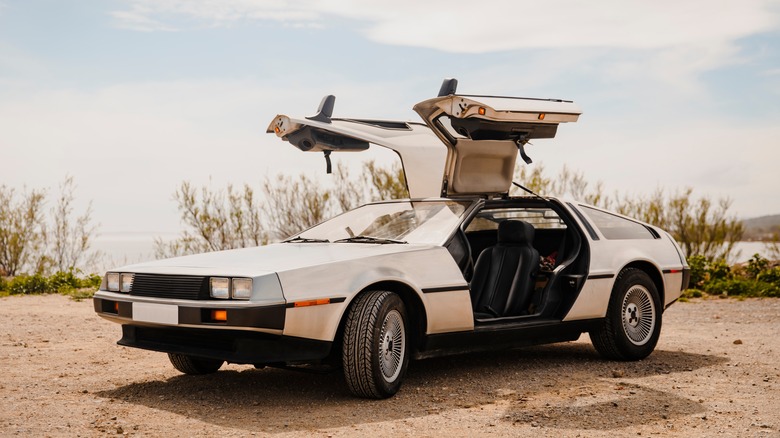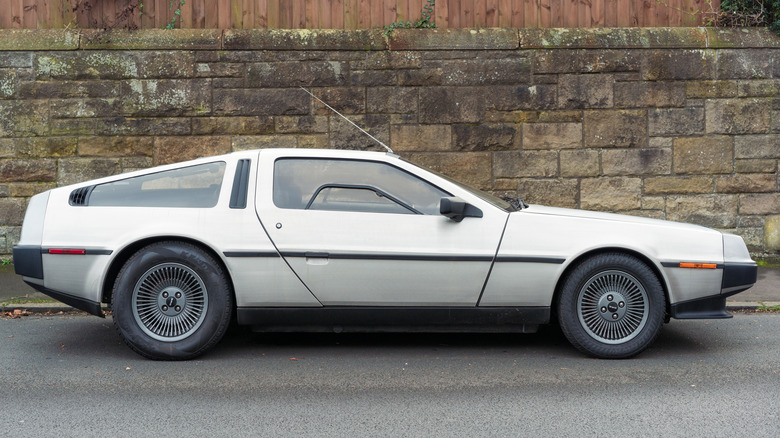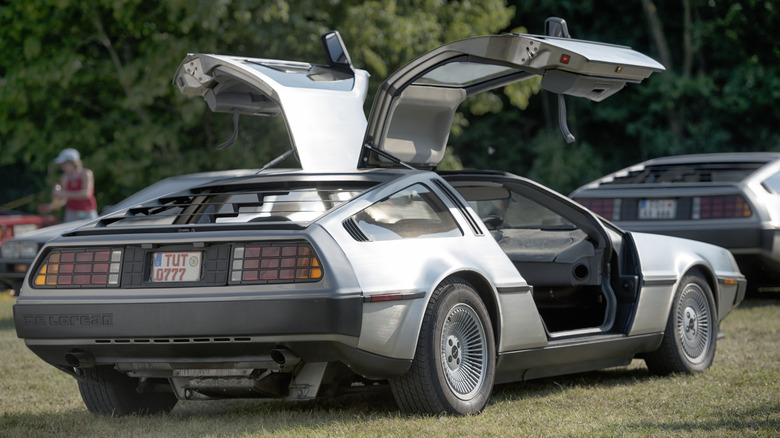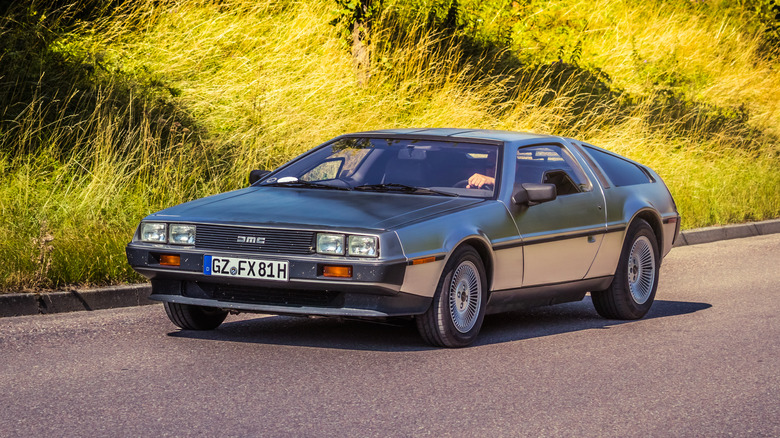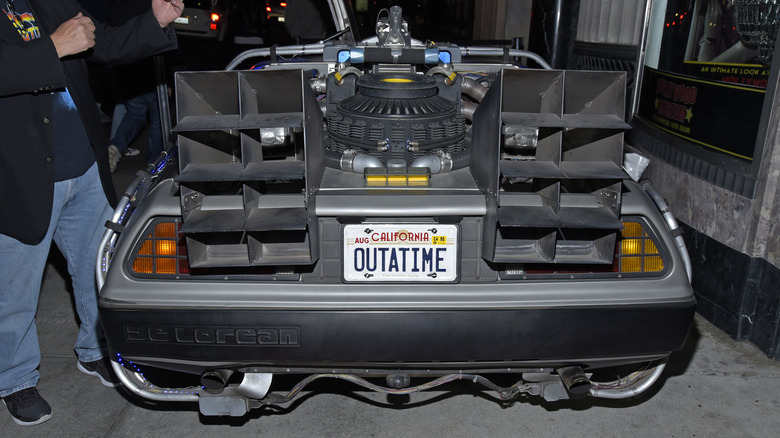How Many DeLoreans Were Made And What's One Worth Today?
You'd be hard-pressed to find someone who didn't know that John DeLorean's stainless steel, gull-winged DMC-12 (one of our coolest cars with the flapping doors) was the iconic pop culture vehicle Doc Brown and Marty McFly used throughout the "Back to the Future" trilogy. What many people may not know, however, is the convoluted history of the man and his company and the short-lived, flash-in-the-pan production run of the car itself.
John DeLorean left General Motors in 1973 after a very successful, almost two-decade-long career. Chrysler hired him after graduating from its Institute of Engineering with a master's degree. A year later, he hopped to the Packard Motor Company, where he worked for four years and eventually headed up its research and development division.
General Motors hired DeLorean in 1956 and tasked him with rejuvenating a lackluster Pontiac line. Over the next 17 years, he would become a legend in the car industry, developing innovations (i.e., wide-track wheels and recessed and articulated windshield wipers) and muscle cars like the GTO in 1964 (what does the GTO stand for?), Firebird (1967), and Grand Prix (1969). Unfortunately, the Arab oil embargo in 1973 created fuel shortages around the globe, quadrupling the price of oil in the United States and effectively killing off these powerful cars.
How many DeLoreans were produced?
The public's attention quickly moved from gas-guzzling V8s to smaller, safer, and more fuel-efficient vehicles. The "Big 3" automakers weren't prepared to shift production quickly enough to make these kinds of automobiles, and DeLorean saw an opportunity. He resigned from GM in 1973 to start his own self-named company (John Z. DeLorean Corporation), with the notion that he could build an American-made sports car — much like the coupes BWM and Mercedes were making — to meet the public's needs.
The DeLorean was powered by a rear-mounted 2.8-liter, all-aluminum V6 Peugeot-Renault-Volvo (PRV) engine that produced a mere 130 horsepower and 153 lb-ft of torque and pushed the 2,700-pound vehicle to 60 mph in a leisurely nine seconds (some claim it took over 10). Some sources claim that between January 1981 and December 1982, only 8,987 were built, while others state as many as 9,080. Official factory records have never been found that list all the cars produced, so the actual number may remain a mystery.
The initial goal was to sell it for $12,000 (thus the "12" designation), but its '81 MSRP was $25,000, which increased to $29,825 in '82. Another price jump to $34,000 occurred in 1983 despite the company's bankruptcy in '82. Sales dropped yearly, with only 3,012 selling in 1981, 2,660 in '82, and 1,009 in its final 1983 year.
How much are DeLoreans worth today?
Quick math tells us that less than 6,700 of the original 9,000 units were sold. Depending on which source you check, the total number of DeLoreans still in existence today varies wildly. According to Britannica, as many as 6,000 could still exist (as of 2023). Meanwhile, the DeLorean Directory states as few as 4,500 cars are in driveable or restoreable condition.
What makes a car rare or collectible is highly subjective. A lower production run certainly helps, and the DeLorean is right on the cusp of what is typically considered "rare." Also adding to its appeal is its unique stainless steel skin and gullwing doors. Lastly, it has a significant place in pop culture history. In 2021, the 1981 DeLorean "hero car" used in the "Back to the Future" films was the 29th car to enter the National Historic Vehicle Register, a claim to fame very few cars achieve.
Its worth is as nebulous as exact production numbers. A lot depends on the car's condition and mileage on the odometer. For instance, one current listing for a car is said to be "museum quality" with "the lowest mile 1983 DMC-12 in the world" (1,543) and has an asking price of $109,495. Another listing for a 1981 DMC with 36,982 miles states it's not running and needs work to make it roadworthy. It has a sale price of $39,950. The DeLorean Motor Company has ten vintage DMCs currently for sale, but you must contact them directly for a price.
The DeLorean was meant to be a model of safety
Let's put some context around how the DMC-12 came into existence. After DeLorean resigned from GM, John DeLorean acquired the license for a new type of impact-resistant foam panel created using elastic reservoir molding (ERM) from Royal Dutch Shell.
These plastic-sandwiched foam panels were super lightweight and incredibly strong and would form his new car's chassisless core. He created a subsidiary company known as the Composite Technology Corporation to manufacture these panels that would sit under the stainless steel skin. The DeLorean Motor Company was established shortly after, and JZDC was renamed the DeLorean Manufacturing Company.
According to Car and Driver, another player was involved early on in developing what would become the DMC-12. Allstate Auto Insurance ponied up $500,000 for DeLorean to create an example of an idyllically "safe" automobile, at least according to the government safety initiatives at the time. Allstate eventually divested itself from the project but, for some unknown reason, let DeLorean keep the seed money.
He knew from the jump that he wanted a few specific things for his car, including the aforementioned stainless-steel bodywork and gullwing doors. It also had to be roomy enough for six-foot-plus tall passengers to fit comfortably. From there, he turned the design process over to famed Ital Design in Turin, Italy, where the legendary Giorgetto Giugiaro (who designed numerous iconic cars) took the reigns. In 1976, Kar Kraft in Detroit assembled the prototype DMC-12 with a transversely mounted four-cylinder Citroën engine.
DeLorean finally ran out of time
A year later, the futuristic stainless steel wonder was unveiled at the National Automobile Dealers Association meeting in New Orleans with hopes of attracting financial support to launch it into mass production. His plan worked because he got nearly 350 dealerships to invest $25,000 each. He received another $1 million from private investors, boosting his seed money to almost $10 million.
But that was nothing compared to the $100+ million Northern Ireland offered, which came with one caveat: the cars had to be manufactured in Belfast. DeLorean agreed and hired Lotus to develop the final production version of the DMC-12. However, Lotus was a British-owned company, an important distinction because the Irish Republican Army was waging a terrorist battle inside Northern Ireland to get Britain to relinquish its rule over the country.
The Belfast plant was erected in under two years and consisted of several buildings because just one presented too big a target. Astonishingly, it was never attacked, and the first DMC-12 rolled off the production floor in 1981. While the buzz was off the chart (American Express offered a 24-karat gold version), the DeLorean entered the U.S. market during the worst economic recession the U.S. had seen since the Great Depression and sold poorly.
DeLorean tried to get help from the British government, but they instead placed the company into receivership. He finally ran out of time in October 1982 when, within a span of a few days, he was arrested for trafficking 55 pounds of cocaine, and the DeLorean Motor Company was forced into bankruptcy.
